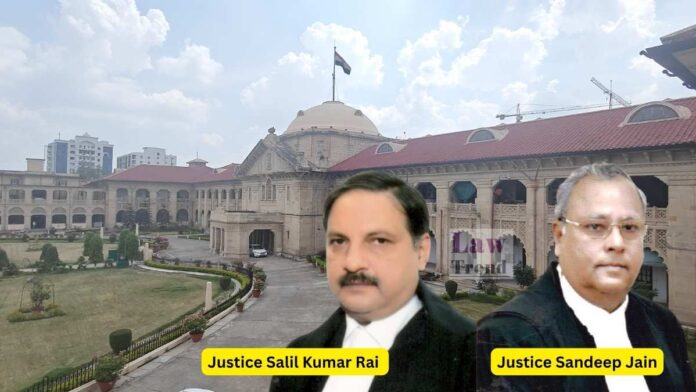The High Court of Judicature at Allahabad has delivered a split verdict in a 1996 criminal appeal concerning the conviction of a man for the murder of his wife in 1991. In Criminal Appeal No. 787 of 1996, a division bench comprising Justice Salil Kumar Rai and Justice Sandeep Jain expressed conflicting opinions on the guilt of the appellant, Shailendra Kumar Mishra.
The appeal challenged the judgement dated 26.4.1996 from the trial court in Session Trial No. 225 of 1992 (arising from Case Crime No. 546 of 1991, P.S. Kotwali, District Fatehpur), which had convicted the appellant under Section 302 IPC for his wife’s murder and sentenced him to life imprisonment.
Justice Salil Kumar Rai, in his judgment, allowed the appeal and acquitted the appellant. Conversely, Justice Sandeep Jain dismissed the appeal, affirming the trial court’s conviction and sentence.

Given the disagreement, the bench, invoking Section 392 Cr.P.C., ordered the case records to be placed before the Hon’ble Chief Justice for nomination to resolve the differing opinions.
Background of the Prosecution Case
The prosecution’s case stated that the deceased, Sunita Devi, was first married to the appellant’s elder brother, Vijay Shankar Mishra, an Air Force employee who died in an air crash. From this marriage, she had two sons, Ajay and Abhay (PW-5). After his death, the deceased received Rs. 2,00,000/- from the Air Force.
Subsequently, she married the appellant, Shailendra Kumar Mishra, and they had a daughter, Soni (PW-4). The prosecution alleged that marital relations were strained because the appellant continuously demanded the deceased transfer her money and landed properties to him, which she refused.
On 26.07.1991, at about 4:45 pm, the appellant allegedly again demanded the money. Upon her refusal, the prosecution claimed he shot her, stating he was killing her for the refusal. The First Information Report (FIR) was lodged by the deceased’s brother, Vijay Krishna Tripathi (PW-1). The FIR claimed PW-1 and his cousin, Mithilesh, heard the gunshot, ran to the house, and saw the appellant fleeing. It further claimed the deceased narrated the entire incident to PW-1 before she died en route to the hospital. The deceased’s children, Soni (PW-4) and Abhay (PW-5), along with a nephew, Amit Kumar, were cited as eyewitnesses.
The Defence Case
The appellant’s defence was that the gun fired accidentally during a “tussle between the deceased and the appellant.” The defence contended that one Pradeep, the brother-in-law of the informant (PW-1), used to visit the deceased in the appellant’s absence. It was alleged that on the day of the incident, a quarrel occurred over Pradeep’s visits. The appellant claimed he was going out to “settle scores with Pradeep” when the deceased tried to prevent him, leading to a scuffle in which the gun accidentally discharged.
In his statement under Section 313 Cr.P.C., the appellant denied demanding money, stating he had his own income. He reiterated that the gun fired accidentally during the tussle over Pradeep. He claimed he ran out to hire a rickshaw to take his wife to the hospital, but upon returning, he saw PW-1 and others gathered, who shouted and chased him, causing him to flee in fear.
Analysis by Justice Salil Kumar Rai (Allowing the Appeal)
Justice Salil Kumar Rai disagreed with the trial court’s conviction and acquitted the appellant, providing the following reasoning:
- On the Informant (PW-1): Justice Rai agreed with the trial court’s assessment that PW-1 “was inimical to the appellant and was not an eye-witness of the incident.” He noted that PW-1 had “financial interests in the properties registered in the name of the deceased” and was an “interested witness.” The judgment highlighted “significant improvements” in PW-1’s testimony, as his claim of seeing the appellant aim and fire was absent in both the FIR and his statement to the Investigating Officer (PW-7).
- On Child Witnesses (PW-4 and PW-5): The judgment observed that both witnesses were of “very tender age” at the time of the incident (6.5 and 11 years, respectively) and deposed four and a half years later. Justice Rai noted “major improvements” in their testimonies, which corroborated PW-1’s improved claims.
- Possibility of Tutoring: Given that PW-4 and PW-5 were under the guardianship of PW-1 after the incident, Justice Rai held, “The possibility that P.W.-4 and P.W.-5 were tutored by P.W.-1 and his family cannot be ruled out.” He concluded their evidence “‘betray shades of tutoring’ and requires corroboration from independent evidence.”
- On Appellant’s 313 Statement: Justice Rai noted that while the appellant’s statement corroborates that the gun was fired during an altercation, the admission “cannot be dissected and the inculpatory part cannot be accepted ignoring the exculpatory part.” Citing Narain Singh v. State of Punjab, the judgment held that an “admission must be used either as a whole or not at all.”
- On the Defence Explanation: The judgment found the appellant’s explanation regarding the tussle over Pradeep to be plausible. Justice Rai noted that the trial court itself had held that the “probability of illicit relations between the deceased and Pradeep cannot be ruled out” and that PW-4 and PW-5 had concealed Pradeep’s visits on the “tutoring of PW-1.”
- On Motive and Premeditation: Justice Rai found the prosecution “has not been able to prove” the motive, as no documentary evidence of the Rs. 2,00,000/- was produced, and PW-1 admitted the deceased’s account had no balance. He also rejected the act of loading the gun as proof of premeditation, noting PW-5’s testimony that the appellant used to take his gun for security when visiting his village.
- Withholding Material Witnesses: The failure of the prosecution to examine Mithilesh and the neighbours, who could have testified to the appellant’s subsequent conduct (his claim of running for a rickshaw), was deemed “fatal to the prosecution.”
- Conclusion: Justice Rai concluded that “two views are possible” based on the evidence, and “the accused is undoubtedly entitled to the benefit of doubt.” He held the prosecution “has not been able to prove beyond doubt that the appellant had intentionally fired at the deceased.”
Analysis by Justice Sandeep Jain (Dismissing the Appeal)
Justice Sandeep Jain affirmed the trial court’s conviction, disagreeing with the reasoning of Justice Rai.
- On the Informant (PW-1): Justice Jain agreed that it was “doubtful” that the deceased made an oral dying declaration to PW-1 and that PW-1 “had not seen the accused shooting Sunita.”
- On Child Witnesses (PW-4 and PW-5): Conversely, Justice Jain found the testimony of the child witnesses credible. He held it was “proved” from their evidence that the appellant, after demanding property, “pointed the barrel of his gun towards the breast of his wife Sunita, and from a distance of about one pace, fired a single shot.” He found this ocular evidence was “corroborated by the admission of the accused in his written statement under section 313 Cr.P.C.” that the shot was fired from his gun.
- On the Defence Explanation (Pradeep): Justice Jain rejected this defence entirely. He noted, “Both the eyewitnesses… categorically denied that Pradeep used to frequently visit their house.” He held, “There is no evidence on record to prove that Sunita was having an extramarital affair with Pradeep. The burden of proving such affair, lies upon the accused, which has not been discharged by him.”
- On Accidental Firing: This explanation was also rejected as “unbelievable because no injuries have been found on the hands and fingers of the deceased during autopsy, as such, the version of scuffle is also rejected.”
- On Motive: Justice Jain found the motive “proved.” He stated that the accused admitted the properties were in Sunita’s name, and his refusal to transfer them was the “real cause of friction.”
- On Premeditation: Justice Jain held that the appellant loading the gun before the deceased returned with water “demonstrates that he was fed up” and “had ultimately made up his mind.” He concluded, “The loading of gun itself proves that accused had made up his mind that he will settle the matter today, itself… This premeditation proves that the accused intended to kill Sunita.”
- On Appellant’s Defence: Justice Jain observed, “It is also apparent that the accused is an Advocate, who has very skilfully crafted his defence under section 313 CrPC which has no substance, which is an afterthought, in order to escape from the credible ocular evidence against him.”
- Conclusion: Justice Jain held that the burden was on the accused to prove that the case fell under an Exception to Section 300 IPC (like grave provocation or sudden fight), which he “utterly failed to prove.” He concluded, “It is proved beyond reasonable doubt that Sunita was intentionally killed by accused on a refusal to transfer property in his favour.”
Final Order
Justice Salil Kumar Rai allowed the appeal and set aside the conviction, acquitting the appellant. Justice Sandeep Jain dismissed the appeal and affirmed the life imprisonment.
(By the Court) “There is disagreement between us regarding the final order in the appeal and the reasons for the same. In view of the aforesaid, let the records of the case be put up before Hon’ble the Chief Justice for nomination under Section 392 Cr.P.C.”







